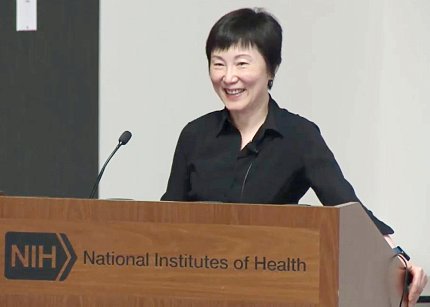Out Like a Light
Professor Expounds on the How and Why of Sleep

Some people routinely get quality sleep; others wish they got more of it. Rest assured, though, everyone gets some sleep; it’s essential for survival.
Every living organism with a nervous system sleeps. Even jellyfish, with their primitive nervous system, catch their Zzzs.
Earlier sleep studies pointed to a single sleep center in the mammalian brain. Recent research instead reveals a larger, distributed and interconnected network of sleep neurons across the brain and beyond.
Dr. Yang Dan, a neurobiology professor at the University of California at Berkeley, recently shed light on the biology of slumber to a packed room in the Porter Neuroscience Research Center. She delivered the Newcomb Memorial Lecture, part of the NIH Neuroscience Seminar series.
“Sleep is an essential innate behavior,” said Dan. “We actually know how to do this before birth. We spend a lot of time sleeping in our mothers’ wombs.”
The methods for detecting and measuring sleep differ depending on the type of creature being studied. For non-mammalian animals, sleep is detected by lack of movement. A Drosophila fly, for example, has a sleep episode if it stays still for five minutes.
A mammal’s sleep can be recorded on electroencephalogram (EEG) to distinguish non-REM sleep versus REM sleep. Another type of test, electromyography (EMG) measures somatic motor activity (voluntary movement), which is present but decreases during sleep. In humans, in addition to EEG and EMG, doctors test sleep quality by monitoring heartbeat and breathing.
In animals and humans, Dan noted the close association between motor control and sleep.

Photo: Asso/Shutterstock
“This is why if you fall asleep during my talk, the first thing I’ll notice is that you’ll nod off because you lose your neck muscle [control],” Dan quipped.
Dan’s research expands on this connection. “Falling asleep is not just about changes in our state of consciousness or brain state that you can measure with an EEG,” she said. “It’s also about reduction of somatic and autonomic motor activity. In the mammalian brain, neurons putting us to sleep are part of motor circuits controlling [this] motor activity.”
But the research field didn’t always link sleep and motor control.
A century ago, the Austrian neurologist Dr. Constantin von Economo determined one specific brain region—the preoptic area of the hypothalamus (POA)—promoted sleep by inhibiting neuromodulating systems. That’s still true. But subsequent studies reveal sleep-promoting neurons in the lower brain stem and the medulla. It turns out, there’s a network of sleep neurons across the brain and in the cardiovascular system.
‘We accidentally stumbled upon a mid-brain region that promotes non-REM sleep quite powerfully,” Dan said. “So it seems the sleep-promoting mechanism is more distributed than the standard textbook model.”
Dan’s team began screening select brain regions. Interestingly, a postdoc in her lab found that some neurons in the amygdala, a brain structure known to be important for emotional regulation, promoted sleep.

Another postdoc found sleep neurons in part of the basal ganglia that controls motor activity. They observed that transitions between behavioral states were not random. A running mouse doesn’t fall asleep seconds after it stops running. Instead, changes are gradual, from big movements to small movements to quiet wakefulness to sleep.
“Sleep is really just a last step in a series of transitions that reduce both mental arousal and motor activity,” Dan said.
“If you’re a systems neuroscientist like me and you optogenetically [controlling neurons with light] activate some neurons in the brain, and you see that every time you turn on the laser, the mouse stops running and starts doing other things, you would say: ‘I found some neurons involved in motor control’…For each of these transitions, there are changes in both EEG (brain state) and EMG (motor activity).”
So for the fly and the jellyfish and other animals with simple nervous systems, sleep likely functions to suppress motor activity.
“It’s only in animals with more complex brains like us where this reduction of brain arousal becomes more important,” Dan speculated. “For those animals, brain states and motor states can be coordinated…by the same sleep neurons that control motor activity and brain states together.”
Why people sleep has a straightforward functional answer but a more complex biological one. Sleep deprivation causes a range of impairments. Getting good sleep enhances learning, memory, mood, the immune and cardiovascular systems and other mind and body functions.
“Sleep benefits all of these different systems,” Dan said.
But does sleep support multiple independent processes and functions or is there a single fundamental process underlying all of the effects?
Dan and team cannot answer this yet but the investigator has a hypothesis. She thinks that inactivating catecholamine—arousing neurotransmitters such as dopamine and noradrenaline—underlies multiple functions of sleep. This is the line of research her team is currently pursuing.
Catecholamine neurons also may yield clues in other research areas. These neurons are especially vulnerable to metabolic stress. They die early in Parkinson’s and Alzheimer’s diseases, and sleep deficits can speed up disease progression.
“One possibility is that sleep simply allows these neurons to take a break and rest and recover from the high metabolic stress caused by high activity during wakefulness,” Dan said. “Maybe shutting down these neurons during sleep once in a while is important not only for their own health and well-being, but also for the other tissues and organs through their interactions with all these other systems.”
